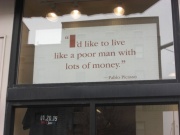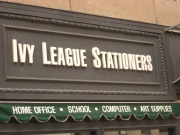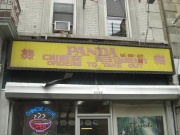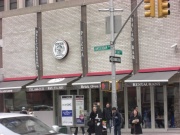From A Neighborhood in Transition
Contents |
Economy
The economy of the Morningside Heights neighborhood is mainly commercial in nature, and is at least partially dependent, if not mostly, on the educational institutions that lie within its borders, namely Columbia University. Upon foraying into the neighborhood, our economics group noticed many economic trends that defined the area. (Note that the economics group focused their study mainly on the portion of the neighborhood between 110th-125th and along Amsterdam Ave and Broadway). Among these are:
1. The Impact of Columbia University
2. Patterns of Residential/Commercial Zones
3. Economic Gentrification Patterns
4. Economic Make-Up of Morningside Heights
Impact of Columbia University
When one thinks of Morningside Heights, the first thing that comes to mind is Columbia University. It is thus reasonable to believe that the university (and the other universities surrounding it, including but not limited to Barnard College, Manhattan School of Music, and various Seminaries) have a profound impact on the economy of the area. While touring the area, we noticed that in the direct periphery of Columbia (112th-118th), many of the buildings were either commercial or academic in nature. This is strongly suggestive of the fact that Columbia has established its own "village" of sorts. Indeed, in the interview below, our Columbia student mentions how the stores around the university receive most of the patronage from the students. We can thus establish the fact that many stores in the area exist to serve the greatest consumer group in the area-- the student. As a result, we find small Delis, Gourmet Supermarkets, Hardware Stores, and Stationary Stores, some of which are shown below.
Since Columbia has purchased much of the real-estate in the surrounding neighborhood, it has had a direct and pronounced effect on gentrification in the neighborhood. Not only are many of the residential buildings in Morningside Heights owned by Columbia, but also much of the real-estate is directly owned and operated for the purpose and advancement of the university. This implies that over the years, much of Morningside Heights’ commercial flavor has been taken over and replaced by academic institutions, creating what economists might call “Economies of Scope”. These are economies where the mom-and-pop shops are taken over by larger businesses and chain-corporations under the umbrella of some greater organization (i.e. Columbia University). This has had the general effect of forcing long-time residents of the neighborhood out and attracting new residents of a higher income class.
Economic Gentrification Patterns
As a result of this economic gentrification, the economic status of the residences experiences an interesting gradient as one progresses from 110th street to 125th street along both Amsterdam and Broadway Avenues. As the street increases towards 116th, we noticed an increase (or at least a high) economic status. This implied that many of the shops catered to a higher class clientele, and many of the residencies were pretty decent. Once at 116th street, directly surrounding the university, the neighborhood experienced its maximum gentrified state. Luscious tree-covered, outdoor bistros, fountains, gothic architecture, and a general light about the place suggested the center of economic activity was in this area, and that it was one of high-caste. This trend continued along until approximately 118th Street. We noticed many gourmet delis, ethnic restaurants of high calibur, bars, high-end shops and retail, educational facilities, seminaries, and much else besides. From 118th street and forward, the evidence of the approaching neighborhood, Harlem, was apparent. All of a sudden stores became shabby, dirty, and to be honest, very shady. The people walking around were no long students of the university, but bums, vagabonds, and lower class inhabitants of Harlem. Bodegas began poking their way through, replacing the Gourmet delis of the Columbia periphery. Eateries were either pizzerias, Chinese take-out, or fast food, and the economics team attests to the fact that some of them are even roach infested. Thus we can conclude that economic gentrifiation is high in the area surrounding Columbia in both directions, yet once one proceeds past approximately 118th street, gentrification drops off, and the economic status is that of Harlem.
The reason for Harlem’s lack of gentrification, and the reason behind Morningside Heights’ bipartisan reality, is explained easily by the definition of the term “agent of gentrification”. The agent of gentrification is the orgnization, person, or entity that is believed to have caused the gentrification in a particular neighborhood. In this case, Columbia is the agent of economic gentrification. Harlem is not directly influenced by Columbia, and thus has not experienced any such gentrification.
Price Differentials
These economic patterns also affect prices in the area. The economics team took note of an apparent price differential as one transverses the neighborhood from 110th to 125th streets. This price differential, expressed as the difference between the cost of a select market basket of goods in one area of the neighborhood, versus its cost in another locale, can be expressed simply as:
(P(x) is a geographic location dependent function, indicating the varying prices of a market basket as one progresses from 110th to 125th streets, with x representing the displacement (in sq,blocks) from 110th street, and with the function p(x) defining the price of a market basket as a function of that displacement. Summing up these prices of market baskets over the region in which we are interested, gives you the total price differential of a distinct market basket from one end of the neighborhood to the other. If one thinks of integration as taking the area under a curve, think of price as the y and number of blocks on the x, then the area=xy=(price per block)(number of blocks)=total price differential
Where P(x) is a function describing the price of a select market basket of goods, as a function of the distance from the 110th street border of the neighborhood, and Dp is the total price differential from one end of the neighborhood to the other. The Total Price differential is important because it denotes the extent to which market externalities, or even market power exists within the neighborhood. Dp indicates how much retailers at 110th st are able to mark-up their prices higher than those at 125th st. This mark-up above the market clearing equilibrium is indicative of some sort of market power, meaning retailers near Columbia University have the market conditions necessary to sell at higher prices.
The economics team noted a few elements of a common market basket, including the price of a slice of pizza, a 20oz bottle of Pepsi, and a street-vendor hot dog. In the downtown area (from 110th-118th) the price was noted as $2.75, $1.75, and $2.00 respectively. In the uptown area (118th-125th) the price was found to be $2.00,$1.50,$1,50. We can see that depending on the item (or the selected market basket), the individual good price differential can be anywhere from $0.25 to $0.75. The cost of a deli sandwich in the prime uptown area of the neighborhood was also about 150% of what it would be in Harlem, costing approximately $6.50.
Economic Make-Up of Morningside Heights
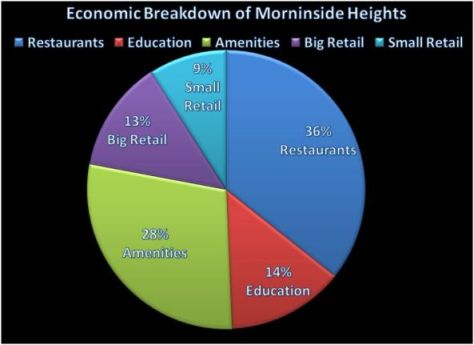
If we take a look at the commercial make-up of Morningside Heights, we see it is greatly concentrated in the service sector. Between catering to its students’ amenities and needs, and providing tourists, New Yorkers, and Inhabitants with a multicultural pantheon of eateries, Morningside Heights exhibits a service-based economy (as opposed to retail-based economy). Restaurants make up the biggest portion of commercial space in the area the economics team surveyed, and ‘Amenities’ the second largest. Retail space combined (both big and small) makes up only 22% of the economy in the area. Education is also a rather large portion, but is not accurately reflected since not all the buildings of the universities and educational institutions were counted, considering they are not businesses, in the proper sense of the term. Each degree-granting institution was counted as one ‘business’.
Also, of note, is the relative dominance of Large Retail over Small Retail. Many residents in the neighborhood complain of large businesses and corporations taking over retail space in the area. What the economics team is referring to as ‘Small Retail’ is being driven out of business, or forced by law to vacate the premise, as larger, cleaner, more efficient and well-known gentrified businesses and retail, takes their place.
Considering the prevalence of education in the neighborhood, one might object to the fact that the above survey was conducted on a per-business basis, rather than on a Per-dollar contributed to the economy standard. If we were to measure the single largest econono-motive force of the neighborhood, it would of course be, Columbia University, as the university owns most, if not all, of the retail and residential space in the area.
Interview with Columbia Student
One Thursday afternoon, we met a friend of mine from Bronx High School of Science, who currently attends Columbia, and asked him a few things about the University and the neighborhood he resides in. Topics covered range from gentrification of the neighborhood, preffered eateries in the area, observed price differentials, caliber of the university and the neighborhood, and general contentedness of the environment.
Thoughts
While making several loops throughout the neighborhood, I noticed how the landscape and the environment, in which I was walking, drastically changed. Progressing from the downtown section to the uptown section (110th-125th), one could notice a not too subtle change in environment. From ornate cathedrals, glorious masonry, and various other adornments of the Academic Acropolis to the rather dingy, dirty, and altogether bleak vision one apprehends when nearing Harlem, the difference is quite staggering. This made me quite aware of the shortcomings of a non-gentrified neighborhood, and of the power an academic institution such as Columbia, has over the neighborhood it occupies.
I was genuinely surprised to find the small café’s, bistro’s and the array of pricey high class multi-ethnic restaurants. The number and quality of gourmet delis was also astounding. No doubt in the spring time, the area also enjoys very beautiful scenery, especially surrounding the very ornately designed Columbia University( I particularly loved the Butler Library, with the Parthenon-design and the inscriptions of famous Greek thinkers about the top). I shall definitely return to experience more of what this neighborhood has to offer some day.
--Andreas
During my initial visit to the Morningside Heights neighborhood, I experienced a very disparate type of environment, contrasting to where I reside in Flushing. With Columbia University and its allied schools dominating the region, one can notice without difficulty the gentrification that has taken place among other sites, including many shops. While taking note of all the businesses that can be found within the Morningside Heights neighborhood, I observed how some stores such as Ivy League Stationers give much benefit to the Columbia University students, such as 10% discounts; some businesses are even named after the university. The environment alters however, when reaching 125th St; the existence of luxurious restaurants or pizzerias, selling their items at quite expensive prices, begin to fade whereas a new chain of deli and grocery stores selling their products at affordable prices becomes present.
The sector surrounding the university deemed to be middle-class, considering that the tuition of the university is approximately $40,000, and the apartment buildings that exist nearby are opulent as well. Infamous businesses such as Starbucks and many pizzerias selling slices for $2.50 can be found also, disclosing that this Columbia region is a bit too pricy, compared to our standards. Nevertheless, the visit brought my attention to some very engrossing sites, including Tom’s Restaurant and the very architecture that makes Columbia University so appealing to its students.
--Mohammad
List of Morningside Heights Businesses
A compiled list of several businesses within Morningside Heights during our journey through the neighborhood is provided
here
The gallery of such businesses is provided below:
Gallery of Morningside Heights Businesses
